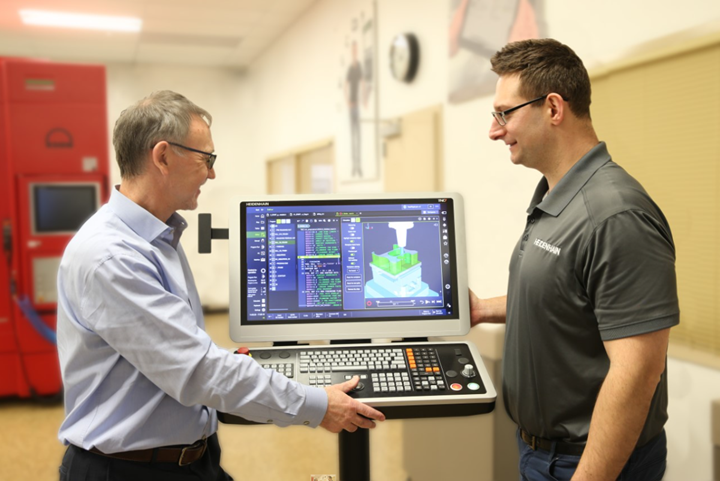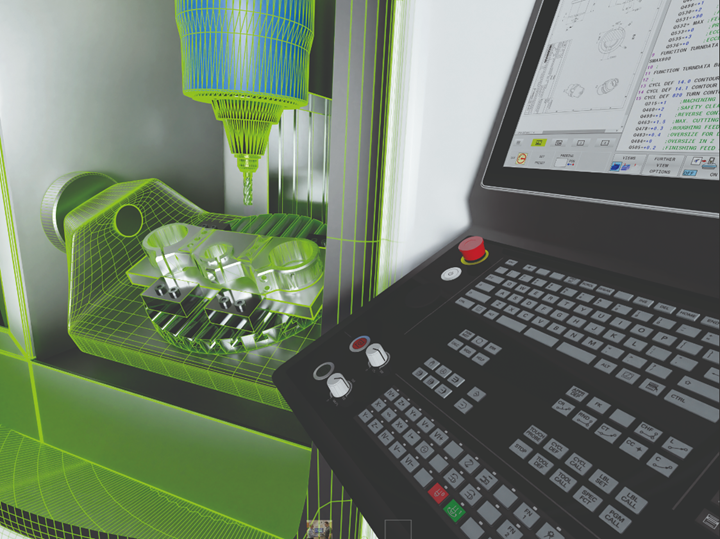Generating a Digital Twin in the CNC
New control technology captures critical data about a machining process and uses it to create a 3D graphical representation of the finished workpiece. This new type of digital twin helps relate machining results to machine performance, leading to better decisions on the shop floor.
Share




Hwacheon Machinery America, Inc.
Featured Content
View More



Autodesk, Inc.
Featured Content
View More
Gisbert Ledvon (left) and Joseph Pizzoferrato, a TNC Application Eng. at Heidenhain’s US headquarters in Schaumburg, IL, discuss the user-reconfigurable display panel on the TNC7 control unit. Photo Credit: Photo Courtesy of Heidenhain Corp.
The digital twin of a machined workpiece is an asset for monitoring and improving part production. Because it is digital, this twin can be analyzed, shared and archived in computer software applications. Information from the digital twin enables operators and shop managers to make sound decisions, often in real time, which would otherwise be out of reach. For example, comparing the digital twin to the CAD model of the part reveals how accurately a machining process has replicated the as-designed geometry, usually by showing a color-coded “heat map” with the results of this comparison.
If worrisome or unacceptable deviations are discovered, corrective actions may be taken before removing the part from the machine or proceeding to the next operation. However, a shop may wish for more than a “skin-deep” comparison between the workpiece geometry and the CAD model. Getting to the root causes of the deviations might prevent reoccurrences or lead to more lasting process changes. A digital twin generated solely by a touch probe or laser scanner is unlikely to be traceable easily to essential aspects of machine performance during the metal cutting process.
To move past this limitation, machine control builder Heidenhain has taken a different approach. Its latest generation of high-end CNC technology as embodied in its TNC7 control system, moves the function of creating the digital twin of the workpiece directly to the CNC itself. In this approach, the digital twin is derived from the toolpath as executed by the CNC, a complete record of all corresponding axis moves, the application of the effects of machine kinematics, the condition of machine structures and other data about machine performance. The result is a digital twin that not only captures workpiece geometry, but also links it to underlying influences on this outcome.

Any computer-generated graphical representation of a physical object might be considered a digital twin. Generating the digital twin of a machined workpiece in the CNC has the advantage of reflecting characteristics of the machining process as recorded by the control’s software.
Photo Credit: Photo Courtesy of Heidenhain Corp.
THE DIGITAL TWIN CONCEPT
There is no precise, standardized definition of the term ‘digital twin.’ Rather, it refers to the general concept that a computer-generated, 3D graphical representation of an actual, physical object can be used as a stand-in for a variety of software applications in manufacturing. Because the digital twin bears a close resemblance to its physical counterpart, results of these applications create an opportunity to improve a manufacturing process significantly without direct access or further manipulation of the material component.
However, how closely the digital twin must resemble its physical counterpart can vary, depending on its intended application. We can see this in the many uses for the digital twins of machine tools.
A relatively simple digital twin of a machine tool may suffice for simulating workflow in a proposed production line. A highly detailed and comprehensive digital twin of a machine tool may be needed for animated simulations of a programmed toolpath to detect possible collisions. For applications of augmented reality, the digital twin of a machine tool suitable for training operators or maintenance personnel may have different requirements for the level of detail and formatting for realistic visualization.
A similar situation exists with the digital twin of a machined workpiece. How much and what kind of information is represented by the twin may vary, partly depending on how and when it is created. Gisbert Ledvon at Heidenhain Corp. says that making the digital twin of a machined workpiece more meaningful in advanced applications is a worthy goal. “The promise of digital twin technology is one of the chief motivations for developing the capability to create a digital twin within this control system,” he says..
The approach embodied in the TNC7 represents a departure from existing digital twin technology and may indicate a shift in how machining companies can implement and benefit from the digital twin concept.

This visualization of a virtual machine tool under the control of CNC software identical to that deployed on the machine’s physical counterpart makes the point that programmers and planners have a more effective means of determining outcomes of actual metalcutting operations.
Photo Credit: Photo Courtesy of Heidenhain Corp.
INSIDE THE CNC
How accurately and precisely a CNC machine produces a workpiece is determined by the entire production system, that is, the CNC toolpath, the conditions of the cutting tool assemblies, the rigidity of fixtures, the attributes of its linear scales, encoders, servo system, axis drives, ballscrews and so on. Ledvon says the TNC7 is designed to capture data about a machining process in great detail. A complete digital history of machine motions can be recorded, showing torque, speed of individual axis moves and corresponding rates of acceleration and deceleration.
Software in the CNC processes this data in real time to create a digital twin that is more than the geometry of the resulting workpiece, although this geometry is the equivalent of that captured by a coordinate measuring machine using a touch probe or scanning probe. The contour of the workpiece is calculated on the control with the simulation modus, which constructs a virtual volumetric entity from the axial motions of the cutter as implied by the NC code in the part program. This process is analogous to the calculations performed in a CAD system to generate a so-called “solid” model based on the designer's geometric input.
What is important is that the virtual properties of the CNC-generated digital twin are related to the performance of the machine and its control system, Ledvon says. Thus, results can be traced to factors such as kinematics of the machine tool. A prior analysis of the PLC files from the machine tool ensures that the kinematics are captured in sufficient detail and accuracy. For example, errors caused by servo lag in the axis drive systems will be reflected in the digital twin in the same way they are present and measurable in the machined workpiece. Likewise, a record of spindle torque can be tied to the digital twin so that dimensional measurements can be associated with the cutting forces corresponding to the specific machining operation under review. By comparing digital twins of subsequent workpieces, changes in part feature size can be tracked along with changes in spindle torque to detect tool wear and predict when tool change optimally should occur.
This kind of insight enables machine operators, programmers and QC personnel to respond with appropriate actions. In short, the CNC-generated digital twin opens new possibilities for a level of process monitoring that is closer to the action and quicker on the draw, so to speak.
TWINS OFFLINE
To reinforce the point that digital twins are an asset in the production of machined parts and that not all digital twins are alike depending on their intended application, a look at another option from Heidenhain is worthwhile. The company offers an accessory called virtualTNC that is an independent programming station based on the actual CNC but operated on a PC. This software is essentially the same as that which powers the TNC control unit on a multi-axis contouring machine tool. A programmer can use the PC-based system utilizing different machine kinematics (for example, a trunnion table rather than a tilting head configuration) to create and test part programs exactly as the programmer would at the CNC unit at the machine tool.
A key capability of the virtual system is that it can be interfaced to a digital twin of the specific machine tool targeted for production, rather than a generic version available from a machine tool builder or CAM software provider. This machine-specific digital twin is customized by reading in the performance data derived from the control unit on the actual machine. The kinematics of this machine and other characteristics are incorporated into the digital twin on the virtual machine.
The benefit, Ledvon says, is that simulation of the NC code delivers high-resolution positioning data to the visualization system. Among other results such as collision detection, is the simulation of machined workpiece that can be inspected at a level of precise detail typically not possible in other simulations. For verifying NC programs of complex molds and dies, aerospace or medical parts with tolerance bands in the microns, this high-resolution virtual part model translates into great confidence that shopfloor results will be successful, even on a first-part sample cut, he says. A CNC-generated digital twin of this machined part would complete the loop from CAD model to program simulation to completed workpiece.
Related Content
How to Mitigate Chatter to Boost Machining Rates
There are usually better solutions to chatter than just reducing the feed rate. Through vibration analysis, the chatter problem can be solved, enabling much higher metal removal rates, better quality and longer tool life.
Read MoreAutomated CAM Programming – Is Your Software Really Delivering?
A look at the latest automation tools in Autodesk Fusion 360 software and how forward-thinking machine shops and manufacturing departments are using them to slash delivery times and win more business.
Read MoreAutomating Part Programming Cuts the Time to Engaging Work
CAM Assist cuts repetition from part programming — early users say it could be a useful tool for training new programmers.
Read MoreTips for Designing CNC Programs That Help Operators
The way a G-code program is formatted directly affects the productivity of the CNC people who use them. Design CNC programs that make CNC setup people and operators’ jobs easier.
Read MoreRead Next
Building Out a Foundation for Student Machinists
Autodesk and Haas have teamed up to produce an introductory course for students that covers the basics of CAD, CAM and CNC while providing them with a portfolio part.
Read MoreRegistration Now Open for the Precision Machining Technology Show (PMTS) 2025
The precision machining industry’s premier event returns to Cleveland, OH, April 1-3.
Read More5 Rules of Thumb for Buying CNC Machine Tools
Use these tips to carefully plan your machine tool purchases and to avoid regretting your decision later.
Read More


































.jpg;maxWidth=300;quality=90)










